Chances are that our longtime readers are already entirely acquainted with the concept of the bug-out bag, that one piece of gear that all preppers love, and you are probably already familiar with its cousin the get-home bag, or GHB.
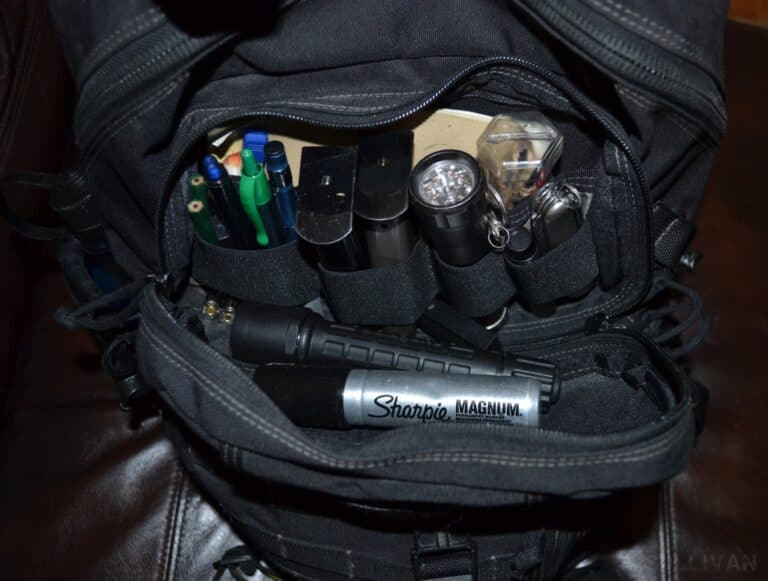
open get home bag with flashlights multitool sharpie and pens showing
The GHB is an invaluable if the underutilized tool in the prepping toolbox: as it turns out, most people get pretty averse to the notion of putting together yet another hefty piece of luggage that they have to haul around with them everywhere they go.
I think that is a shame, and these folks, however understandable their complaint might be, are missing out on one of the single best preps that they could make use of.
The chances of you needing to get home from wherever you are before you can properly get ready to face whatever disaster is looming or has already occurred are quite high and that makes a great case for the get-home bag.
What to do? Simple: we need to put together a get-home bag that is so small, slender, and light that most folks won’t have any excuse at all for going without it.
In this article we’ll be exploring the reason why every prepper should use a get-home bag as well as how to assemble a superior miniaturized version.

Why Do I Need a GHB?
Many preppers balk at the idea of assembling a GHB on principle. Their reasoning goes that since they have already put together a BOB, they don’t need some smaller, seemingly lesser bag filled with largely similar equipment.
Besides, if they really wanted that capability while away from home they could just throw their BOB in their vehicle or take it to the office with them, right? Some of these folks (and you might be one of them) think the GHB just sounds redundant.
That is a fair assessment, but turning a more nuanced eye on the subject shows some flaws with that reasoning.
First, we must consider where our BOB’s can fit, and I’m not just talking about our trunks or our closets at home.
The average bug-out bag is a large piece of luggage, packed to bursting with all sorts of equipment, supplies and other assorted gear that you’ll need to survive and sustain while bugging out.
These bags almost invariably look out of place, even suspicious, anywhere except perhaps on a hiking trail.
Stowing one of these bags in your trunk is fine, but leaving it in the cabin of your vehicle or towing it into the office with you, just in case, is bound to attract attention and the kind of attention you don’t want in this day and age.
Also, chances are you won’t be taking off into the wild blue yonder from the get-go when an SHTF situation occurs while you are away from home.
The chances are, in fact, quite high that you will need to head home first, or head elsewhere prior to pushing off to your first BOL.
Why? Simple, most of us are not total loners; we have family members including spouses, children, and perhaps even elderly parents that we care for.
You might just have a cherished pet at home, or neighbors that need a little looking out for.
Rendezvous Before You Retreat
Consider that your family members have lives of their own and a better than average chance that they too will be out of the house and scattered around your hometown.
They will, in the absence of other, or detailed instructions, head for home in times of trouble.
If you are in the middle of a commute, at the office, out running errands, or anywhere else at the beginning of a situation that will result in you bugging out you will probably still need to head home in order to rendezvous with them.
In that situation, do you really want to be hauling a full-size BOB round for what is likely to be a comparatively short, intense, high-speed movement home? I will assert that you probably do not.
Instead, what is needed is a more specialized bag that will furnish you only what you need to cover your bare essentials for a 24-hour period, max.
That is as much time as most of us will need to make it home under duress in most situations.
Correspondingly, this pack and its contents should be kept as light and as lean as possible since we are no longer truly preparing for an event that warrants a BOB; it is waiting for us at home, anyway!
Bottom line, a GHB is a right and proper tool for this particular job. Now, all we need to do is put the thing together.
Before You Assemble, Assess Your Context
Even considering the specialized nature of the GHB compared to the BOB you must still carefully assess your own parameters for use.
Everyone’s lives, capabilities, and solutions are not the same, and you should not think for a moment that there is a truly universal one size fits all when it comes to GHB’s.
Consider the various factors that will go into this decision before you choose a bag and then start assembling the contents:
Workplace Setting
Where do you work, and what kind of job do you do? What is the dress code like?
Do you have cover for bringing a small bag into the office as well as a safe place to stash it, especially considering that the contents might include items that could be viewed in a negative light depending on your workplace culture?
Do you have lockers for a private office, or will you be forced to simply hide the bag under your desk?
What is Your Commute Like?
How long is your commute is to and from work, how do you get there, and what is the route actually like?
If you drive your personally owned vehicle there and back again you’ll have more options than you would if you take a bus or ride the train.
What is the actual round-trip distance from your home to your office? 20 or 30 miles is still easily achievable with most GHB setups, but if you have a 100 mile round trip commute you might need to bring “more bag” to bear, so to speak.
Consider Proximity of Coworkers/Commuters
Are your coworkers nosy snitches and busybodies? If you carpool, what are your carpool mates like?
Will the presence of your GHB raise uncomfortable questions? If so, it is best to choose a piece of luggage that will blend in seamlessly with your outfit and office culture.
In short, start thinking about how the bag will travel with you and where you will store it, and if this will create waves or introduce specific vulnerabilities for you or your gear.
Once you have answers to these questions and queries it is time to move to select the bag itself.
Mini-GHB Selection Criteria
Choosing the bag itself is an important part of assembling a proper GHB. However, this is usually an easier process than selecting a BOB because we are afforded far more latitude when it comes to appearance, rigging, and other essential characteristics.
Durability and ruggedness in particular, while still important, are not absolutely vital as they are with a BOB because this bag is not going to be loaded anywhere near as heavily as that piece of prepper kit.
Consider the following criteria below:
Size
As indicated, we are trying to keep the size of our mini-GHB as small as possible. Light, lean and minimalist are the watch words.
First, we are carrying a comparatively light survival load, and the small size of the pack will constrain us into adhering to that load decision.
Second, smaller backpacks just attract less attention no matter the setting, or at least they do compare to large and unruly hiking packs or rucksacks.
Style
Style isn’t just a personal choice. Particularly for the mini-GHB, which might be expected to live in your vehicle, travel with you on the bus or train, or accompany you in and out of the office regularly carefully choosing a pack that will blend in seamlessly to your typical out-of-home environment is important for mission success.
Casual office settings or blue-collar work will necessitate a different pack than something you would expect to see in the echelons of higher management.
In your typical setting, if you would give somebody the “stink eye” for carrying your style of prospective pack, pick something else.
Durability
Compared to a BOB, durability is not the end-all, be-all factor for mini-GHB selection, but it is still important.
This pack will still be hauling a respectable amount of gear and might be subjected to a fair bit of abuse, including inclement weather.
For that reason, quality is still important in order to assure durability. Even if you were going with something totally mundane like a typical JanSport-style day pack, choose one from a reputable manufacturer so you know it will hold up for the long haul.
Suspension
Even on the mini-GHB, this suspension is important, as you’re going to be carrying it quite a long way and doing so under challenging circumstances.
This is not a time when you want the pack to be fighting you or making you more miserable than you already are.
The pack straps should provide some cushioning while also keeping the pack high between your shoulder blades.
Straps that bite into you painfully or allow the pack to skitter around wherever it wants to go are going to be hell on efficiency.
Most packs that we would consider in this size category will lack a waist belt entirely but if you are fortunate enough to find one that has a stowable or attachable belt consider that a bonus.
Weather Resistance
Lastly, try to choose a pack that has at least some weather and water resistance.
Packs made from cotton cloth will soak up a ton of water and grow exponentially heavier in addition to allowing your contents to likewise become soaked.
Something as simple as densely woven nylon that has been treated with a water repellent surface coating might be sufficient for the task, but classic options like waxed canvas (though heavy) are still viable options.
Don’t forget you can always include a thick trash bag or dedicated rainfly to help shield your pack and the items it carries from bad weather.
Now that we have a grasp on what we should consider when it comes to our pack, let us take a look at our packing list!

Your Mini-GHB Basic Loadout
The following items constitute an extremely capable, if basic, mini-GHB load.
No matter where you are or what you do these items should serve you well, though as always be sure to include any additional equipment or make substitutions based on your specific environment and other requirements.
Whatever you decide to change, keep the following primary selection criteria in mind:
Multi-purpose: The ideal item for inclusion in a mini-GHB is multipurpose, meaning it can accomplish more than one task effectively.
This will help you prepare for the greatest possible spectrum of obstacles and challenges while keeping your load to a minimum.
Size/weight – More so than other survival loads, we must keep the overall weight and bulk of our mini GHB down.
This is not only to enable us to move as quickly as possible but also to keep the pack itself as unobtrusive and innocuous-looking as achievable.
This helps us carry, transport, and position the pack while drawing as little attention to ourselves as we can.
You should always challenge yourself to find a smaller, lighter version of the needed equipment you plan on including.
With those two criteria in mind, let us get on to the list.
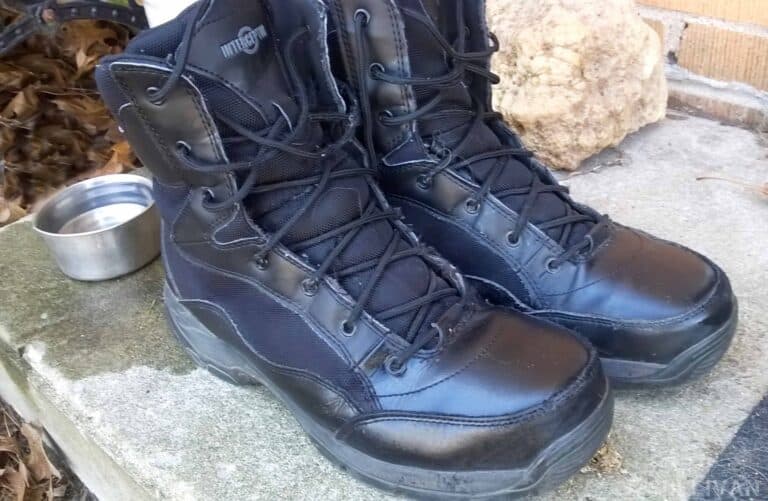
waterproofed boots sitting in the sun to dry
Footwear
Footwear might be a peculiar inclusion for a mini-GHB at first glance because it is bulky.
I want to qualify this inclusion by stating that you should only include footwear if your typical shoes or boots were worn at your job are completely inadequate to the task of making rapid movement home by foot.
Anything that is going to raise blisters or kill your feet is a liability. Depending on how you store your GHB you might just be able to keep footwear near the bag to be put on when the balloon goes up.
Also, certain ultra light, ultra flexible footwear is worth considering or insertion into the bag itself, Lem’s Boulder boots are one good option for certain preppers.
Clothing
Clothing inclusion should be minimalist also and intended to cover any shortcomings of typical daily wear.
Outerwear, depending upon climate and season, is mandatory, and depending on what your usual office wear looks like you might toss in a set of hiking pants and a lightweight, quick-drying top to go with it.
Also, don’t forget the headgear to protect your head and neck from sun exposure.
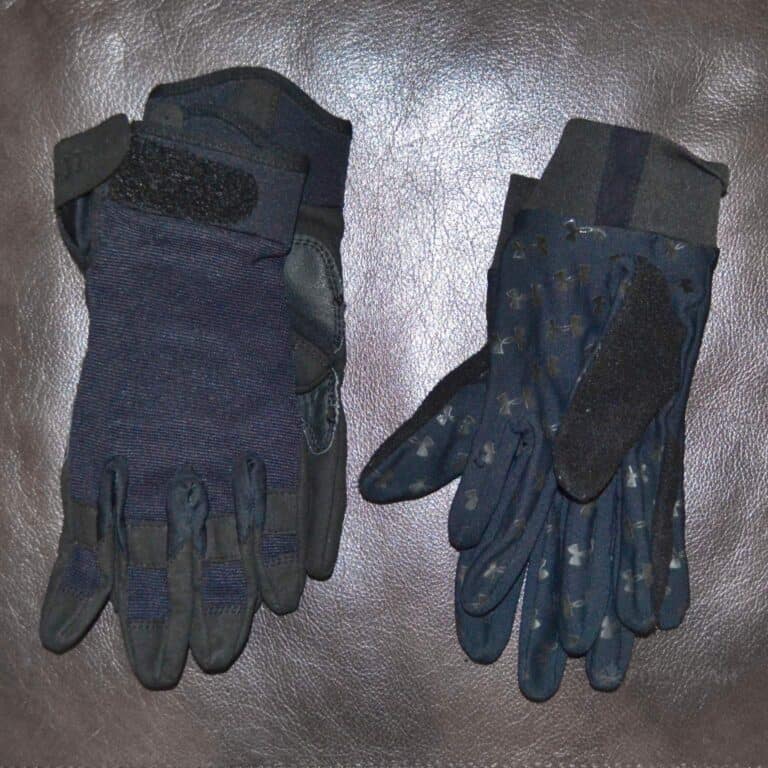
a pair of black work gloves
Gloves
Virtually every emergency situation rates the use of gloves to protect the hands.
Major disasters, man-created catastrophes, and terrorist attacks alike will leave behind a considerable amount of debris, most of its sharp or jagged, that can badly hurt you.
Give your hands a little help by including a heavy-duty pair of leather work gloves or, if you want more dexterity, a pair of “second skin” technical gloves.
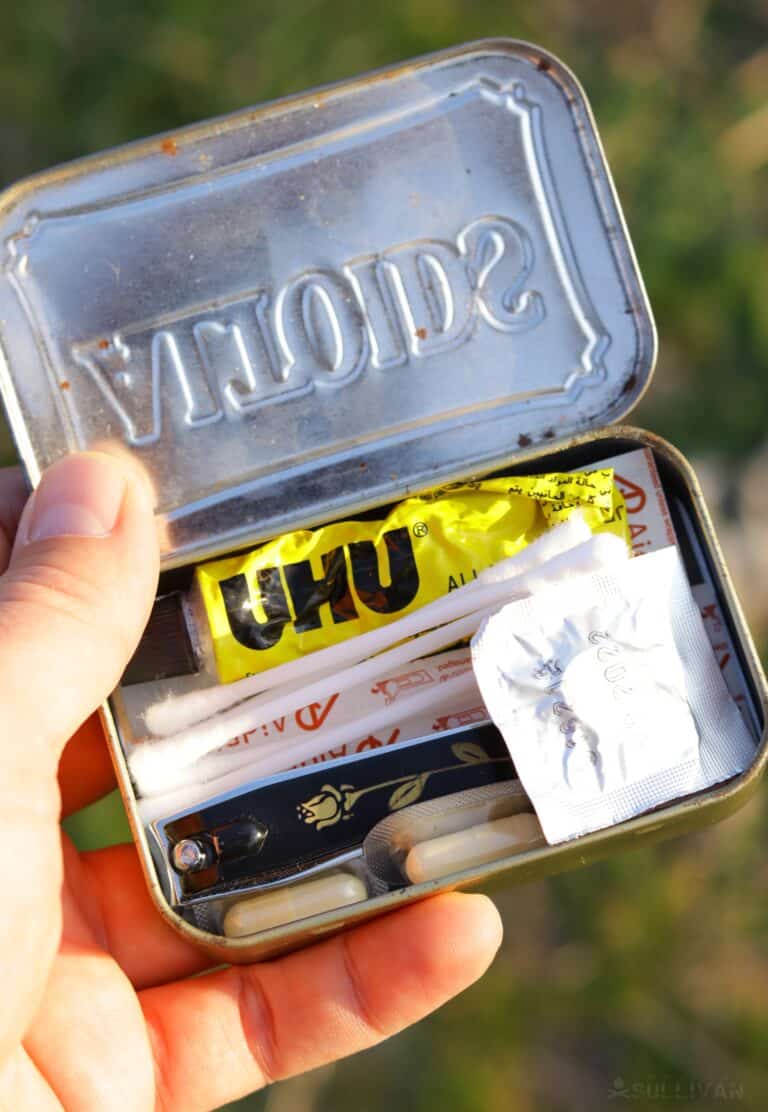
first aid kit items inside an Altoids tin
First-Aid Kit
No prepper should ever go without a first-aid kit. The one in your GHB should be capable of handling common minor and some major injuries.
Items for small cuts, scrapes, puncture wounds, and burns as well as blisters and a variety of over-the-counter meds are an auto-include.
You should also have some gear needed for dealing with more serious lacerations and penetrating injuries, things like gauze, quick-clot, tourniquets, and so on.
Make sure you learn how to use all this stuff or it won’t do you any good.
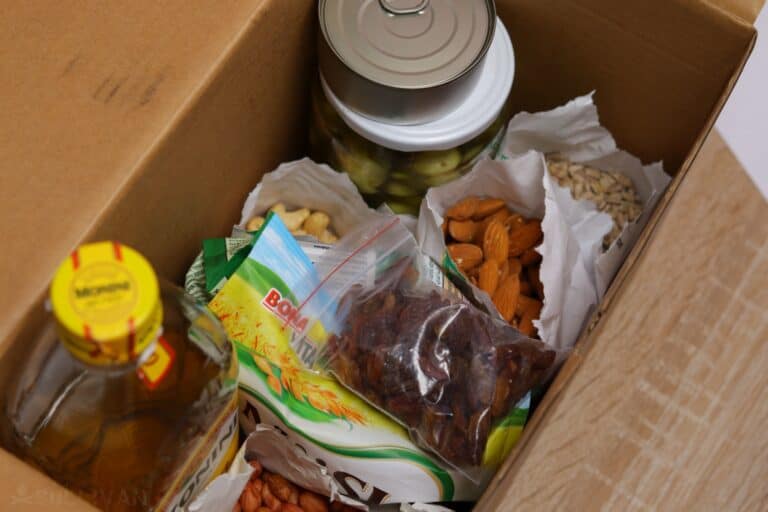
almonds raisins peanuts cashews sardines olive oil and sunflower seeds in box
Food
Compared to a bug-out bag we aren’t going to carry much food in our GHB.
All we want are selections that are going to keep us gassed up with both quick and long-burning energy to help us make tracks when getting home.
Typical trail food like beef jerky, energy bars, nuts, and so forth are good choices, but you might make a case for including more substantial fare like a broken down MRE if you are facing a long journey. Whatever it is must be completely shelf-stable and ready to eat with zero preparation.
Water and Water Filter
Water is an essential survival resource, and we will need some here in our GHB but it is a shame it is so dang heavy.
A single water bottle, kept full with clean drinking water, and accompanied by an easy-to-use emergency water filter like the LifeStraw should prove adequate for the task of keeping you hydrated while you get home.
If any potential route you would take is almost entirely devoid of water you might need to add more bottles or a bigger bottle to begin with.
Cash
Though some preppers decry the use of cash as a survival resource, thinking that in a societal collapse scenario it will be useless, take heart that that is not going to be the case most of the time, at least not quickly.
Cash can get you what you need from anyone who is selling, and can also get you favors when you really, really need one. Make sure you keep a nice-sized wad of cash in your GHB and keep it safe.
GPS
Compact GPS systems are a godsend when the world gets turned upside down, so long as the system’s many interlinked components are all intact.
Some folks have the notion in mind that a GPS system will buckle at the first sign of trouble, but this is not true, as they are shockingly durable and reliable, nearly proof against all but the most cataclysmic events.
Note that a dedicated system will prove more reliable than a phone-based one much of the time, so invest accordingly.
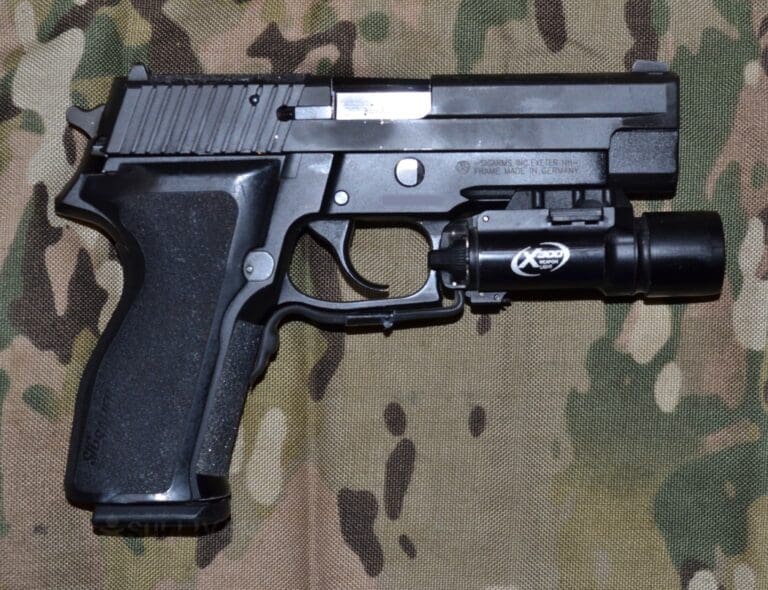
A WML mounted on a pistol
Pistol
Some of the biggest threats you will face in any serious SHTF situation will come from your fellow human beings, not from natural events and not from animals.
It stands to reason you will need to protect yourself, and for this purpose a pistol is your best bet.
Don’t go overloading your get-home bag with a massive, full-size gun and a bunch of spare mags.
Choose an ultra-light .22 caliber semi-auto or revolver with however many ammunition feeding devices to make you feel comfortable, and then toss in a couple of small boxes of .22 ammo.
You’ll have hundreds of rounds on hand for only a few extra ounces. Though nobody’s first choice for a “serious business” gun, the humble, timeless .22 is more than capable of working as a “break contact” gun.

SABRE Pepper Spray, with 100MPH Tape Securing the Trigger Mechanism
Pepper Spray
Not every problem needs to be solved with a pistol, and applying the pistol as an incorrect solution to a perceived problem can actually make the situation worse.
For these self-defense problems, pepper spray works like a charm, affording you plenty of reach and a high degree of effectiveness when you want to knock the fight out of someone without truly harming them.
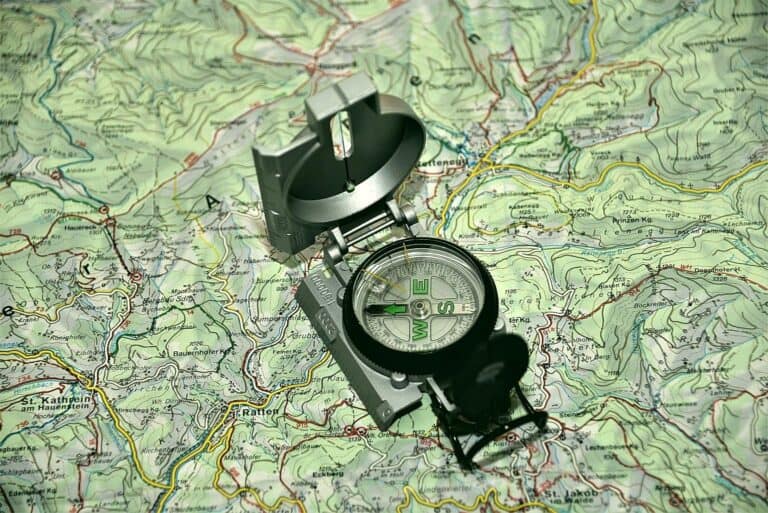
a map and compass
Maps and Compass
You won’t always be able to count on a GPS, for your GPS might be lost, broken or have no power.
Regardless, even if you know your area and region like the back of your hand, you would be a fool to not include a good map and compact compass in your GHB.
You never know when you might need to take a detour, or when the one day you have additional duty somewhere out of town or in a place you are unfamiliar with will turn out to be the one that sees you needing your GHB after all.

open get home bag with flashlights multitool sharpie and pens showing
Flashlight and Headlamp
You’ll never be truly prepared without a good flashlight, and for bonus points, a good headlamp.
You can pick your favorites here for inclusion into your GHB so long as they are not massive and heavy.
Make sure you include extra batteries for each or a spare, charged power bank if they are rechargeables.
Notepad
You’ll have all kinds of reasons to jot down notes during a disaster, stuff like critical information about the overall situation, evacuation details, and other things.
Also, consider that you might need to leave a note for someone, scratch out a rough map or record all sorts of other details that you cannot trust your brain to recall.
You should choose a notepad that is water- and weather-resistant, and also include an equally capable all-weather pen.
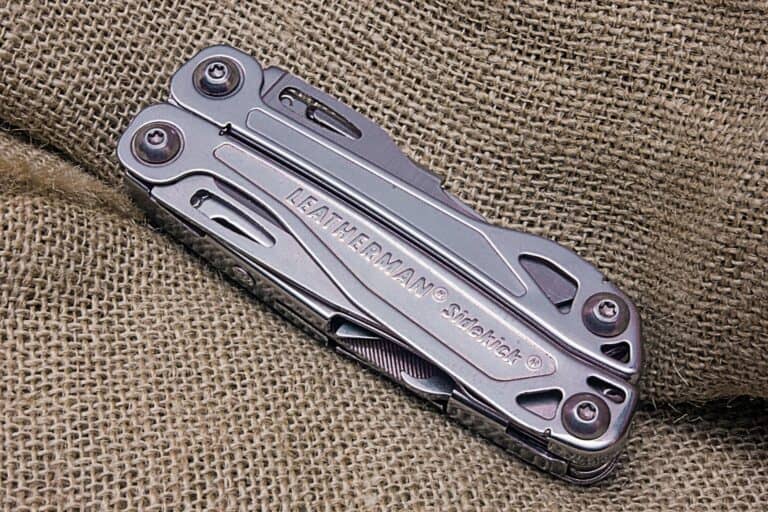
Leatherman
For most preppers on the move a handy Leatherman multi-tool, or equivalent from another brand, can easily replace a small tool chest’s worth of separate tools.
Though the tools are not as efficient or as effective as their full-size counterparts most of the time, the weight and space savings afforded to you by these ubiquitous multi-tools make them too good to pass up, and you’ll find innumerable uses for it in the field.
Tarp and Cordage
In a bug-out bag, you would probably carry a full-size tent or bivy to provide shelter.
For our get-home bag, we are going to omit both and hopefully won’t have any call to utilize a proper shelter at all.
However, you never know exactly what might happen or what you’ll be facing, and since exposure is a major killer you’ll need some way to get yourself out of the wind and rain when demanded.
A sturdy tarp with strong grommets and a hank of tough cord-like paracord can be fashioned into all sorts of improvised shelters no matter the situation, and both are so light they are easy inclusions in our kit.
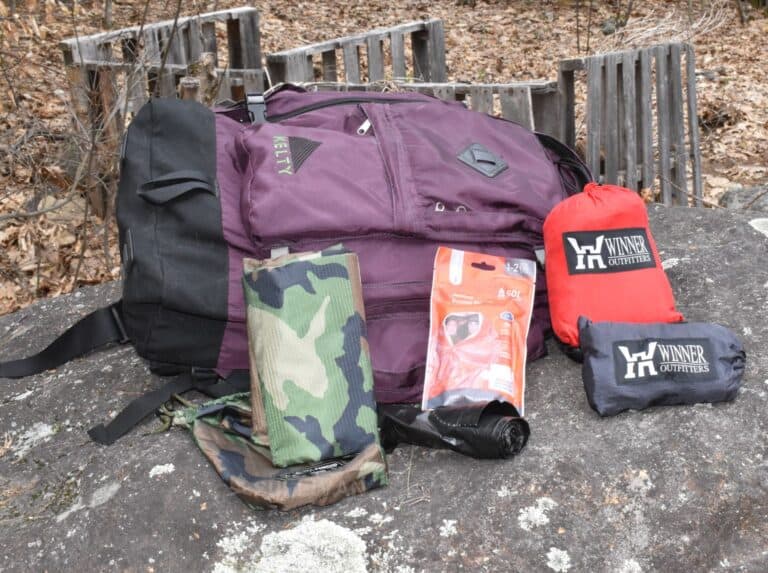
tarps and emergency blanket next to backpack
Emergency Blanket
Think of the emergency blanket, those crinkly foil “space” blankets, as a counterpart to the tarp above when it comes to providing shelter for ourselves.
When temperatures start to fall, you can use the emergency blanket to wrap yourself up like a big prepper burrito, and you’ll stay much warmer than you would otherwise.
These also make excellent reflectors for use with a campfire to cut down on heat loss and keep you warm on both sides.
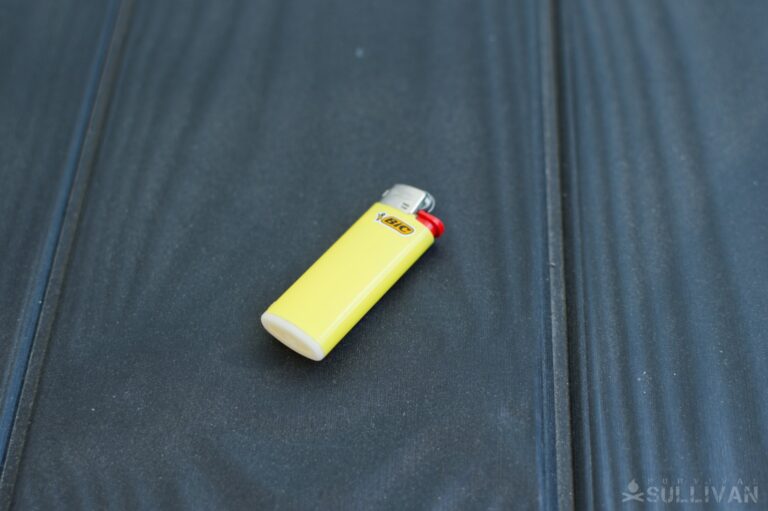
a Bic lighter
Lighter and Tinder
Even though we aren’t planning on sheltering any more than we need to, sometimes there is no replacement for a fire. For getting warm, drying out or signaling for help, nothing beats a campfire.
Fuel is abundant in most places, but it is starting the fire that proves the most challenging. You can save yourself a ton of work and aggravation by using a modern, reliable lighter.
Toss a couple of Bics in your GHB and keep them in crush-proof containers so they don’t accidentally lose fuel when their triggers get depressed.
Also include some sort of tinder that will help you get larger kindling and fuel started properly and reliably.
Dryer lint or cotton balls soaked with Vaseline are my go-to, but there are also commercial fire starters that work.

Conclusion
The get-home bag serves as an important missing link in a prepper’s disaster readiness plan.
Smaller, less bulky, and more agile than a typical BOB, it nonetheless contains vital gear that can help you make your way home whenever disaster strikes while you are away.
Properly chosen and set up, your mini GHB can accompany you virtually everywhere without attracting undue attention, making it a useful and perfect addition to your survival supplies.
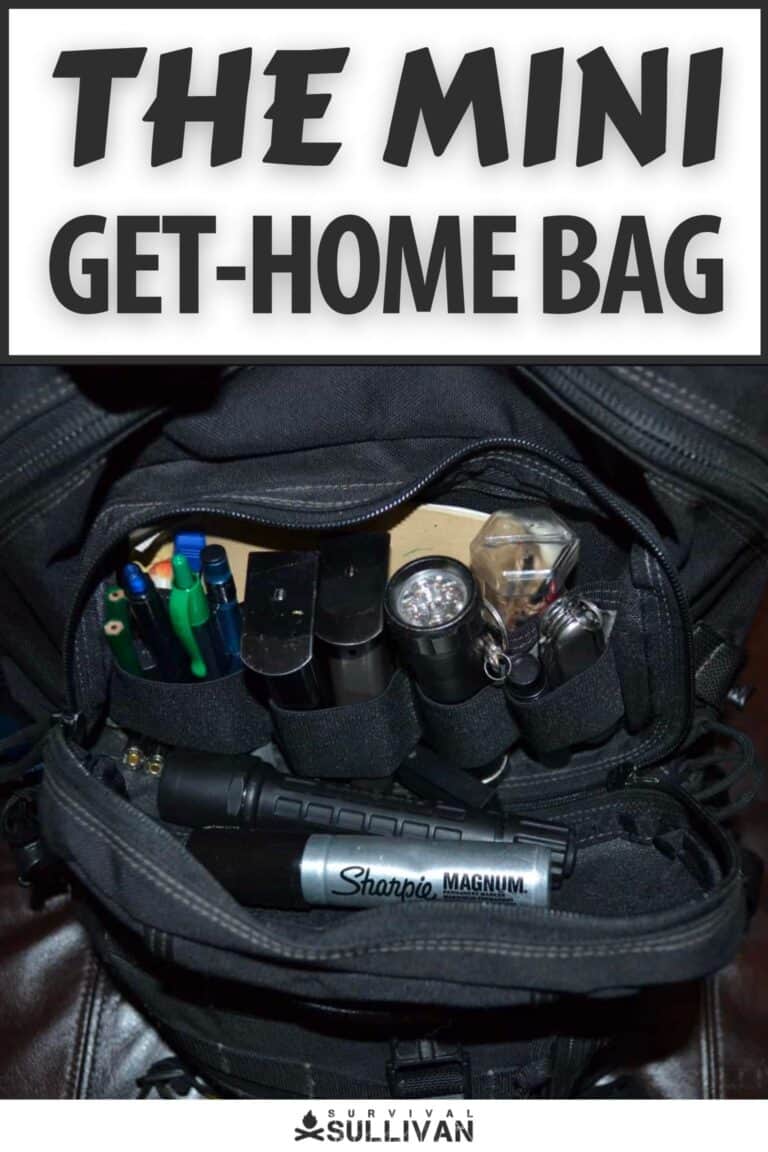
The post The Mini Get-Home Bag: How to Assemble Your Own appeared first on Survival Sullivan.
By: Tom Marlowe
Title: The Mini Get-Home Bag: How to Assemble Your Own
Sourced From: www.survivalsullivan.com/mini-get-home-bag/
Published Date: Wed, 20 Jul 2022 16:00:00 +0000
-------------------------------------------------------------------------
 CampingSurvivalistHuntingFishingExploringHikingPrivacy PolicyTerms And Conditions
CampingSurvivalistHuntingFishingExploringHikingPrivacy PolicyTerms And Conditions
